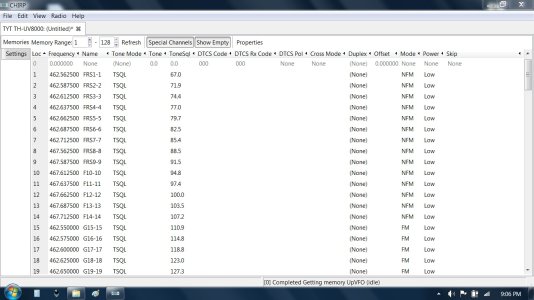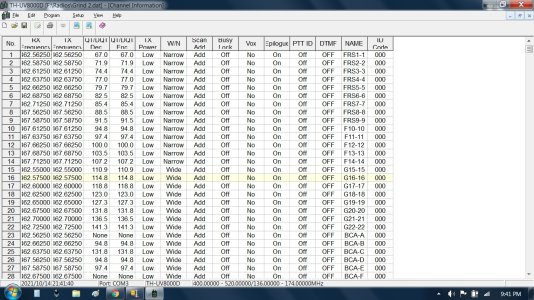Teth-Air
Active VIP Member
For about 2 years now I have been playing around with the TYT UV8000D/E radios. What makes these radios unique over the Baofeng radios are:
1. they are 10 Watt (and tests indicate so but frequency dependant of course)
2. they have a built in cross band repeater function.
3. better battery life
BTW the D model and E model are exactly the same except the D had old software and now the one I see online have all been upgraded to the new software. Look for this note when purchasing.
They also are supported by their own download software that is a litttle easier to understand than the CHIRP programmer but lacks cutting and pasting options for editing. CHIRP does also work but some features don't always get toggled propery through CHIRP so using both programs together are best.
Most funtions are the same as the Baofengs for programming and using. A program cable is required but came with my radio.
Here is what you get:
https://www.aliexpress.com/item/329...&terminal_id=d70db3e9cfc747c7891861cd920f1dd6
So to explain the crossband repeater function and it's advantage. This radio can recieve on UHF and simutaniously repeat a transmission of the same on VHF or vise-versa. Which ever it recieves on it will also transmit on the other through the same antenna. This function allows 2 other radios to communicate ( e.g. Baofengs) through the repeater where those 2 Baofeng radios may be too far apart to communicate. Or an obstructions such as a mountain stands between the 2 radios. For this to work the repeater must be in a location that can be reached by both Baofengs, such as on a mountain top.
Also for this to work the Baofengs must be programmed to "dual watch" so they can recieve on one UHF frequency and one VHF frequency that match the 2 frequencies chosen on the repeater. If this is set up correctly the 2 Baofengs will communicate as normal without the repeater, while they are in range of each other, but will also bounce the signal through the repeater to add that extra range when spread too far apart, on either side of the repeater radio. A common pitfall for programming this is that your Baofeng can switch channels on you to the last frquency it recieved on. This can be annoying so we recommned setting up so channel "A" receives UHF and Channel "B" recieves VHF (or vise-versa) but both "A" and "B" transmit on the same frequency. This is easily done if you are familiar with split frequency programming.
For the repeater, it is a good idea to require a sub-audiable squelch tone to be received to allow them to repeat. The Baofengs need to have this tone programmed to be sent with transmission. This can be important so random interference does not keep the repeater in a transmit mode that can heat them up.
Like any of these radios you risk breaking the law without having your licence, so be warned and check your federal government restricitons/rules for repeaters.
These radios are really good value, durable and have nice sound. They are slightly larger than some but for the large battery and extra function they are worth it.
If anyone has questions I have no problem helping out.
Chris
1. they are 10 Watt (and tests indicate so but frequency dependant of course)
2. they have a built in cross band repeater function.
3. better battery life
BTW the D model and E model are exactly the same except the D had old software and now the one I see online have all been upgraded to the new software. Look for this note when purchasing.
They also are supported by their own download software that is a litttle easier to understand than the CHIRP programmer but lacks cutting and pasting options for editing. CHIRP does also work but some features don't always get toggled propery through CHIRP so using both programs together are best.
Most funtions are the same as the Baofengs for programming and using. A program cable is required but came with my radio.
Here is what you get:
https://www.aliexpress.com/item/329...&terminal_id=d70db3e9cfc747c7891861cd920f1dd6
So to explain the crossband repeater function and it's advantage. This radio can recieve on UHF and simutaniously repeat a transmission of the same on VHF or vise-versa. Which ever it recieves on it will also transmit on the other through the same antenna. This function allows 2 other radios to communicate ( e.g. Baofengs) through the repeater where those 2 Baofeng radios may be too far apart to communicate. Or an obstructions such as a mountain stands between the 2 radios. For this to work the repeater must be in a location that can be reached by both Baofengs, such as on a mountain top.
Also for this to work the Baofengs must be programmed to "dual watch" so they can recieve on one UHF frequency and one VHF frequency that match the 2 frequencies chosen on the repeater. If this is set up correctly the 2 Baofengs will communicate as normal without the repeater, while they are in range of each other, but will also bounce the signal through the repeater to add that extra range when spread too far apart, on either side of the repeater radio. A common pitfall for programming this is that your Baofeng can switch channels on you to the last frquency it recieved on. This can be annoying so we recommned setting up so channel "A" receives UHF and Channel "B" recieves VHF (or vise-versa) but both "A" and "B" transmit on the same frequency. This is easily done if you are familiar with split frequency programming.
For the repeater, it is a good idea to require a sub-audiable squelch tone to be received to allow them to repeat. The Baofengs need to have this tone programmed to be sent with transmission. This can be important so random interference does not keep the repeater in a transmit mode that can heat them up.
Like any of these radios you risk breaking the law without having your licence, so be warned and check your federal government restricitons/rules for repeaters.
These radios are really good value, durable and have nice sound. They are slightly larger than some but for the large battery and extra function they are worth it.
If anyone has questions I have no problem helping out.
Chris








